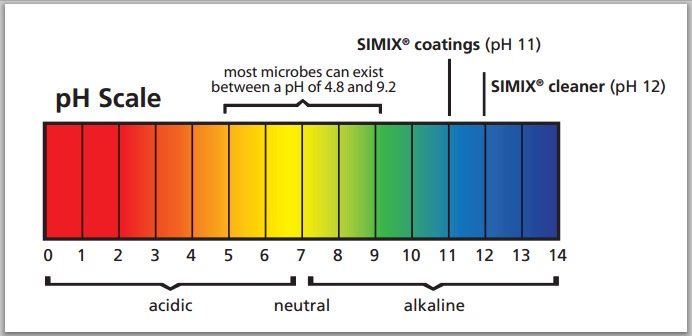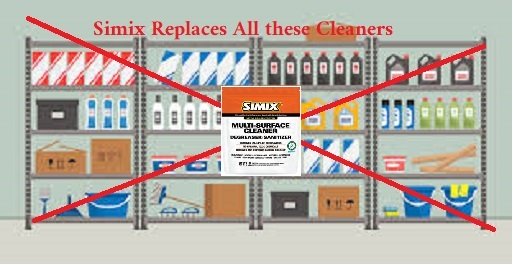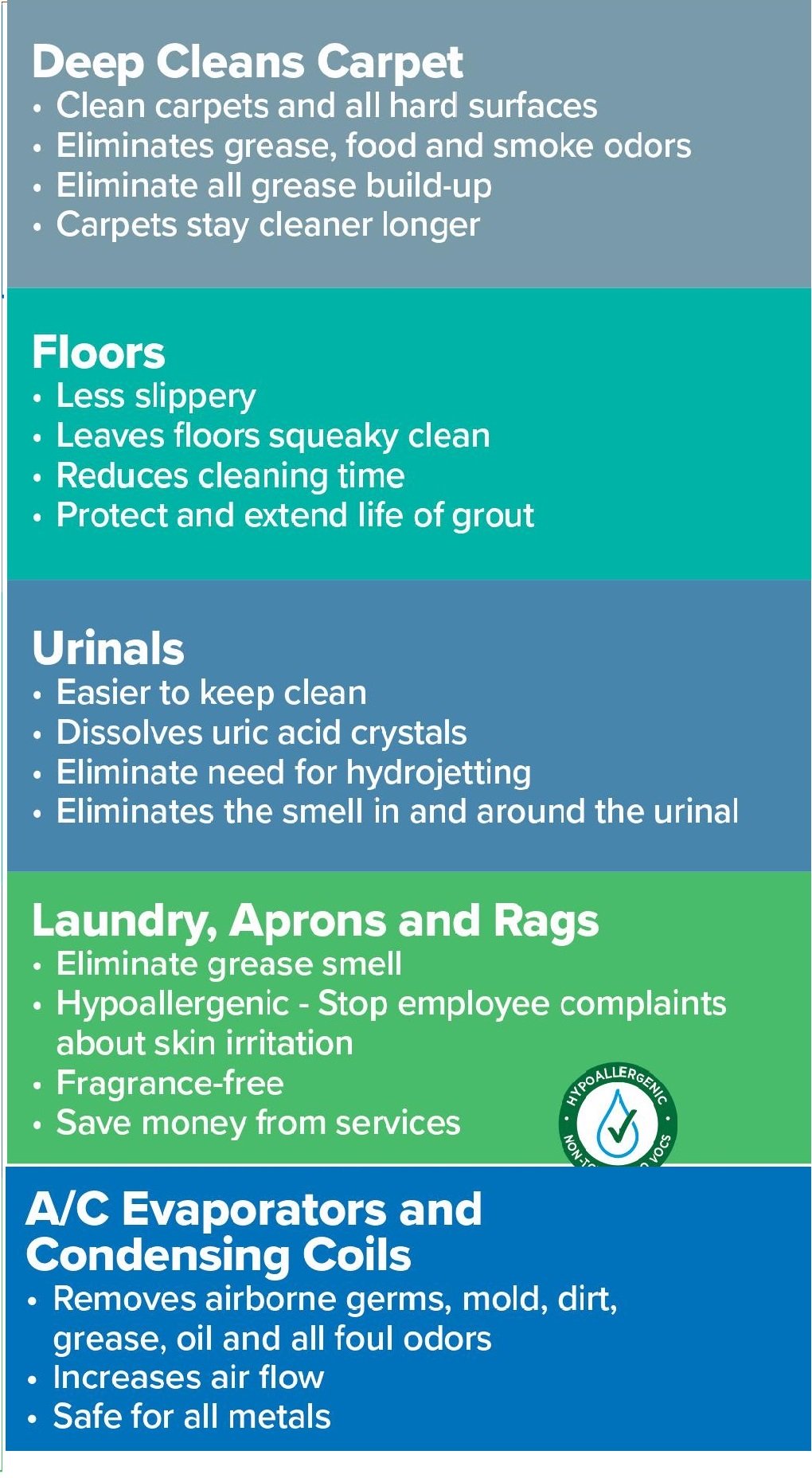The Next Generation of Biosecurity: How Photocatalytic Science in Simix Could Aid the Fight Against
Equine Herpes Virus
The recent EHV outbreak underscores a fundamental truth in managing infectious diseases: traditional cleaning methods often fall short of providing sustained protection. While the initial deep clean is vital, a pathogen as persistent as Equine Herpesvirus-1 (EHV-1) demands a cleaning technology that keeps working long after the mop water is dumped.
In facility maintenance areas like restaurants, schools, and major commercial facilities—where Simix Multi Surface Clean Degreaser Sanitizer is already trusted—the focus is moving toward active surface management. The secret weapon in this strategy is one of the cleaner's core ingredients: photocatalytic titanium dioxide and high ph that is safe around animals and no bleach.

Leveraging Facility Maintenance Innovation: How Simix Cleaner's Proven Viral Reduction Could Aid Equine Biosecurity Against
Equine Herpes Virus
The outbreak of Equine Herpesvirus (EHV) is a stark reminder of the devastating speed and scope of viral transmission within the equine industry. Controlling EHV-1, in particular, hinges on rigorous and effective biosecurity measures, especially the cleaning and maintenance of shared spaces and surfaces. While the challenges of controlling pathogens in barn environments are unique, facilities management—including restaurants, schools, and commercial maintenance areas where Simix products are currently utilized and
NSF approved —has already adopted advanced solutions to tackle persistent microbial threats. An analysis of the performance data for Simix Multi Surface Clean Degreaser Sanitizer shows a compelling potential for this product to be a critical tool in the fight against equine pathogens, should it be adopted for use in barns. The Cleaning Challenge: Viral Persistence in Equine Facilities with Equine Herpes Virus.
EHV spreads via respiratory droplets and direct contact, but also through contaminated equipment and surfaces, known as fomites. Traditional cleaners offer a momentary solution, but the rugged, often porous surfaces of stalls, aisleways, and trailers can make it difficult to maintain a clean viral load long enough to prevent transmission. A successful biosecurity protocol requires a cleaning agent that can significantly reduce the viral presence on non-porous surfaces, minimizing the chance of viral pickup.
The technical evaluation conducted on Simix’s cleaner and its coatings (Samples 1 and 2) focused specifically on the Non-Porous Surface Cleaning Following Virus Inoculation. This testing methodology, which utilizes glazed ceramic tile as a non-porous substrate, is highly relevant to barn surfaces like sealed concrete floors, painted metal stall fronts, and the plastic or fiberglass components of trailers and feeding equipment. Powerful Results Against Key Viral Surrogates
The testing evaluated the reduction in infective-virus counts recovered from surfaces cleaned with the Simix Multi Surface Clean Degreaser Sanitizer The challenge organisms used in the study were:
- Feline infectious peritonitis virus (FIPV-1146, P20), identified in the report as a coronavirus.
- Feline Calicivirus (F-9), identified as a norovirus surrogate.
- Because the product demonstrated high effectiveness against the highly resistant, non-enveloped Feline Calicivirus (FCV) at a greater than 99.999% reduction, it is scientifically expected to be effective against the less resistant, enveloped Equine Herpes Virus (EHV)
These viruses, particularly the coronavirus, are relevant surrogates for enveloped viruses like EHV, providing a strong indicator of the cleaning product's potential effectiveness against this type of pathogen.


Simix cleaner is highly effective at reducing viral load on non-porous surfaces, achieving a 99.94% reduction in recovered infective coronavirus surrogate counts (FIPV-1146). This immediate action is crucial. However, the true innovation of is its ability to provide a layer of sustained, passive antiviral activity.
 |
When Simix is used, a microscopic residue of is deposited onto the cleaned surface. This mineral acts as a photocatalyst.
1 When exposed to light—even the ambient light found in a barn aisle or the dim daylight filtering into a stall—the titanium dioxide absorbs photons and initiates a chemical reaction.
2 This process generates highly unstable and powerful oxidizers known as Reactive Oxygen Species (ROS), primarily hydroxyl radicals
4This is where the science directly confronts a virus like EHV-1. EHV-1 is an enveloped virus, meaning it is encased in a protective outer fatty layer. The ROS generated by the ti02 are incredibly destructive; they actively attack and break down the molecular structure of organic compounds.
6 In the context of a virus, this means the hydroxyl radicals degrade the lipid envelope and the critical surface proteins that the virus needs to attach to and infect a host cell
This mechanism offers a compelling potential advantage in equine environments:
Beyond the Initial Wipe: A Passive, Persistent DefenseThe Mechanism: Disrupting the Viral EnvelopeApplying Commercial Facility Standards to Equine Biosecurityfacility maintenance and food service areas is predicated on these two properties: aggressive immediate cleaning and sustained environmental hygiene. These are precisely the needs of a barn fighting EHV
As demonstrated by the Situ Biosciences Microbial Product Test Laboratory report,
When Simix is used, a microscopic residue of is deposited onto the cleaned surface. This mineral acts as a photocatalyst and attacks Equine Herpes Virus.

1 When exposed to light—even the ambient light found in a barn aisle or the dim daylight filtering into a stall—the titanium dioxide absorbs photons and initiates a chemical reaction.
2 This process generates highly unstable and powerful oxidizers known as Reactive Oxygen Species (ROS), primarily hydroxyl radicals
4This is where the science directly confronts a virus like EHV-1. EHV-1 is an enveloped virus, meaning it is encased in a protective outer fatty layer. The ROS generated by the ti02 are incredibly destructive; they actively attack and break down the molecular structure of organic compounds.
6 In the context of a virus, this means the hydroxyl radicals degrade the lipid envelope and the critical surface proteins that the virus needs to attach to and infect a host cell
This mechanism offers a compelling potential advantage in equine environments:
- Continuous Activity: Unlike traditional disinfectants that evaporate and cease to work, the tio2 remains on the non-porous surface, reactivating every time it is exposed to light. This means areas like metal stall bars, wash stall walls, or the dashboards of large maintenance equipment could maintain a level of viral hostility 24/7, as long as some light is present.
- Destruction, Not Just Neutralization: Photocatalysis does not just temporarily neutralize a virus; the ROS work to decompose and mineralize the viral particles into harmless substances like carbon dioxide and water. This complete destruction is a powerful tool against tough-to-kill pathogens.
The use of Simix in demanding
Imagine a large training barn or school facility:
- Staff uses the Simix Multi Surface Cleaner (Sample 3) as directed (e.g., on sealed concrete floors and metal stall doors) achieving the proven $99.94\ viral reduction against infectious particles.
- After the cleaning crew leaves, the trace tio2 residue begins its work. As light enters the aisle, the surfaces are constantly generating ROS, reducing the survival rate of any new viral droplets that land on the surface from coughing, snorting, or human contact.
It is important to reiterate that while the cleaning product has documented efficacy against a viral surrogate,
Simix is not currently marketed for or specifically tested against EHV-1 in a barn environment. However, the scientific evidence showing tio2's ability to destroy the structure of enveloped viruses (like those in the coronavirus and influenza families) provides a robust theoretical foundation.10 For facilities managing an outbreak, adopting a technology that provides this continuous, passive cleaning layer on hard, non-porous surfaces—a benefit already relied upon in high-hygiene commercial settings—could be a logical and powerful step forward in securing the environment against viral threats.






